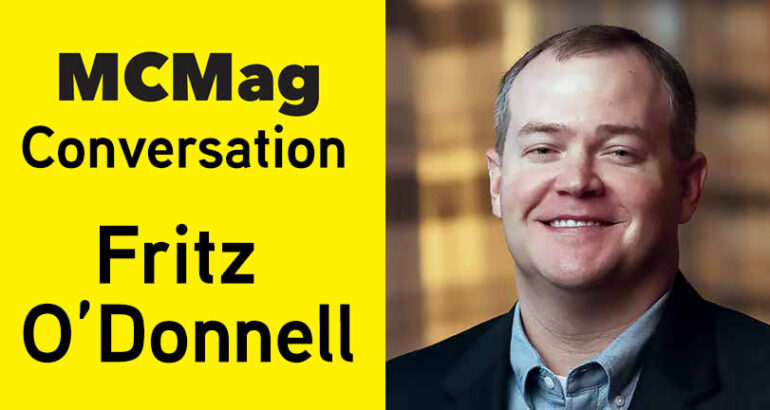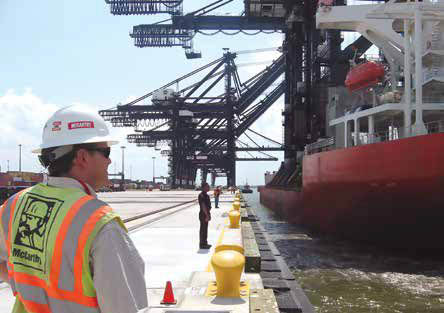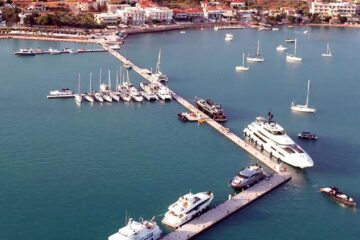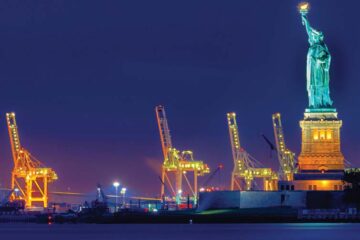Fitz O’Donnell comes from Alabama – he’s an Auburn-trained civil engineer – but he’s right in the middle of the bustling Texas ports expansion. As head of McCarthy’s Heavy Civil Marine & Industrial business unit in Houston, he has 21 years in the industry, the last 12 with McCarthy.
Marine Construction Magazine: Your experience is pretty broad, from building bridges to water treatment plants.
Fitz O’Donnell: Yes. After college, I traveled around the country, working on various projects. The things that are important on a bridge are different from what‘s important on a treatment plant. I came to McCarthy, moved to Houston and I’ve been here ever since.
MCM: Has the current economic environment had an effect on long-term projects?
FO: Not on the public side. The Port of Houston, for whom we’ve done work for 20 years, continues to expand their Bayport facility, which opened 15 years ago. We’re working on a container yard project, and they have a current project out for bid. The Freeport channel has projects out for bid. In the pandemic, everyone has had to make adjustments as to how we do business. But the public side is moving forward with expansion and rehabilitation projects.
MCM: Obviously, no one has ever dealt with what we’ve been dealing with over the last 120 days. How has it impacted your operations?
FO: McCarthy is a national company, and we have divisions in other states that had to respond to COVID-19 before we did. They already had developed response programs for screening, how we were going to comply with regulations and stay-at-home orders, and what businesses were designated as critical. We really leveraged the entirety of the company to put these policies and programs in place. Social distancing, staggered shifts—all things we continue to do.
MCM: What are you seeing in port work that’s a change from how ports were constructed in the past?
FO: We’re seeing expansion to become more efficient. The Panama Canal expansion that was completed four years ago was driving port expansion work for 10 to 15 years. Everyone was trying to get ready for the increased tonnage. The logistics programs and software that ports are using have made them incredibly efficient. The Barbours Cut Terminal, one of Port Houston’s container terminals, has a 300-acre yard, but the average time it takes a truck to go through security, deliver its container and come back out is only 39 minutes. The work is done in phases so the Port can keep traffic moving. We tell them we’ll be finished with a 10-acre parcel on Friday, they say, “great,” and when we come to work on Monday, the entire 10 acres is stacked five-high with containers. The speed and quantity of moving cargo is amazing.
MCM: Are we approaching the limits of the size of ports?
FO: I think the major port facilities are seeing that their existing channels are almost at their limits, based on the increased size and quantity of ships. Freeport is going to start this year on their Freeport Harbor Channel Improvement Project. They’re spending about $300 million to widen and deepen their channel coming in from the Gulf. Port Houston has what they call Project 11, which is the 11th improvement, going back to the late 1800s, of what used to be called Buffalo Bayou. They’re going to spend a billion dollars over five to seven years to widen and deepen their channel from Galveston Bay to the Turning Basin, which is only a few miles from downtown Houston. Same thing for the Corpus Christi and Charleston, South Carolina ports. But it takes time and a lot money, environmental impact studies and getting all the stakeholders involved to expand a port. It’s a major undertaking.
MCM: Your company places a high importance on job safety. Has technology helped make the workplace safer?
FO: The ship-to-shore cranes are still operated by humans, but measurement and communication devices are improving safety. There are things in place to aid the crane operators position the trucks underneath them, and less room for operator error. On our end, the construction side, one of the best technologies to improve safety is the smartphone. Someone on a barge can call and ask if bad weather is approaching. We can use group texting apps to communicate information across an entire job site in real-time. Houston at this time of year is very hot, and we share information throughout the day on temperature and heat index, so that we can take appropriate measures to avoid the impacts of prolonged heat exposure. In addition, all of our safety inspections, training records, all of our statistical reports across the whole company are kept in an online platform that allows us to identify trends and indicators in safety. When we see things, we can take action at the project level— across the entire country, if needed. We’re proactive, versus reactive.
MCM: McCarthy has a company-wide safety council.
FO: Yes, each of our five geographic regions has a safety director who reports to the national safety director and VP of safety. The council has been very active during the pandemic. Mandating the use of masks, for example, is not a simple action. We need to think about how that is going to affect people at every level. What questions will they have? What kind of masks? Are there exceptions? We have almost 5,000 people including partners working across the country. We have to think about how that is going to apply to every individual. If we create a policy, we have to enforce it. That’s how safety works. If you just make rules that no one follows, you don’t have a safety program.
MCM: Is the success of your approach related to the fact that the company is 100% employee-owned?
FO: I think it is. When Hurricane Harvey hit three years ago, we had to figure out some things on the fly, what to do with certain job sites. But that was locally focused, whereas this is a world-wide pandemic. We share information because we care about each other.
MCM: What’s the most fun part about your job?
FO: For me, it’s visiting job sites and seeing things get built. I ride out to the crane barge, visit with the pilot and crew. Seeing some of the young people evolve, get exposed to things and take on more responsibility.
MCM: What’s hardest thing?
FO: The hardest thing we deal with—as a company in a specialized field of construction—is the shortage of people with the proper experience to do this type of work successfully. What is the best use of our people, the most important thing that McCarthy has? You can’t just find people who know how to drive pile and erect steel in the Yellow Pages. We have to make sure we’re giving our people an opportunity to succeed, but also the opportunity to grow in their careers and develop the next group of leaders on the job.
Republished from Marine Construction Magazine Issue V, 2022










